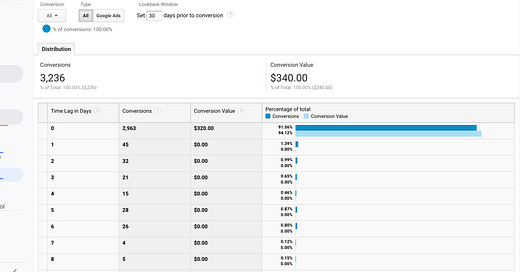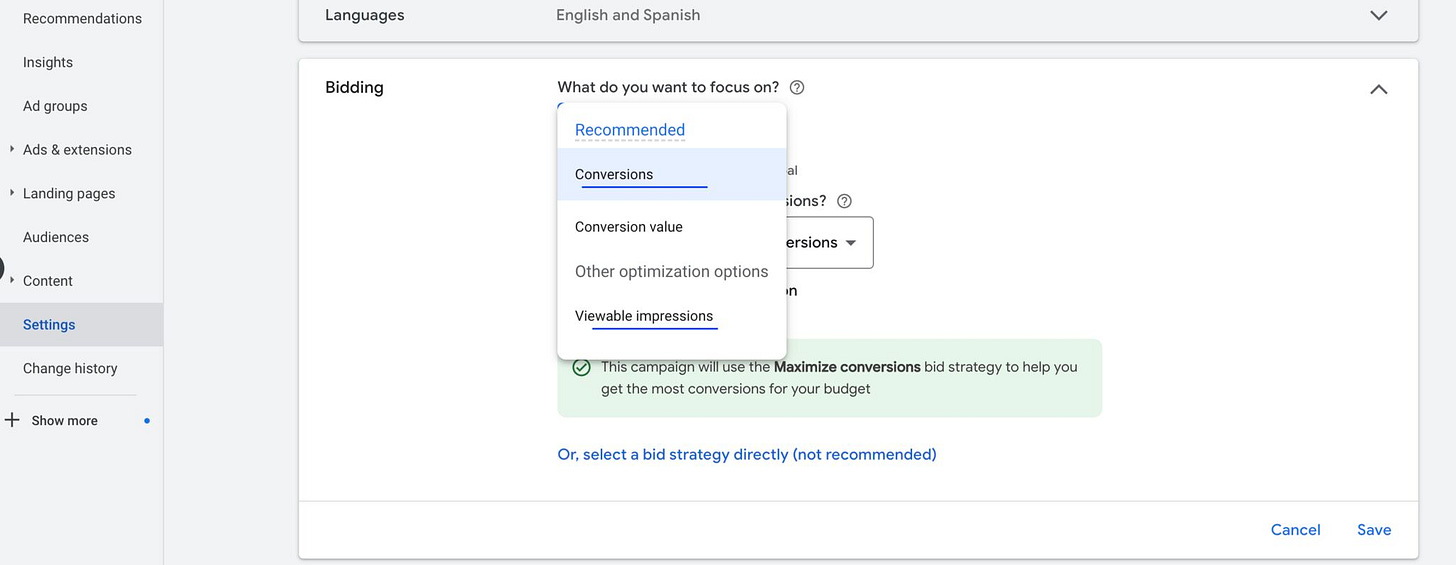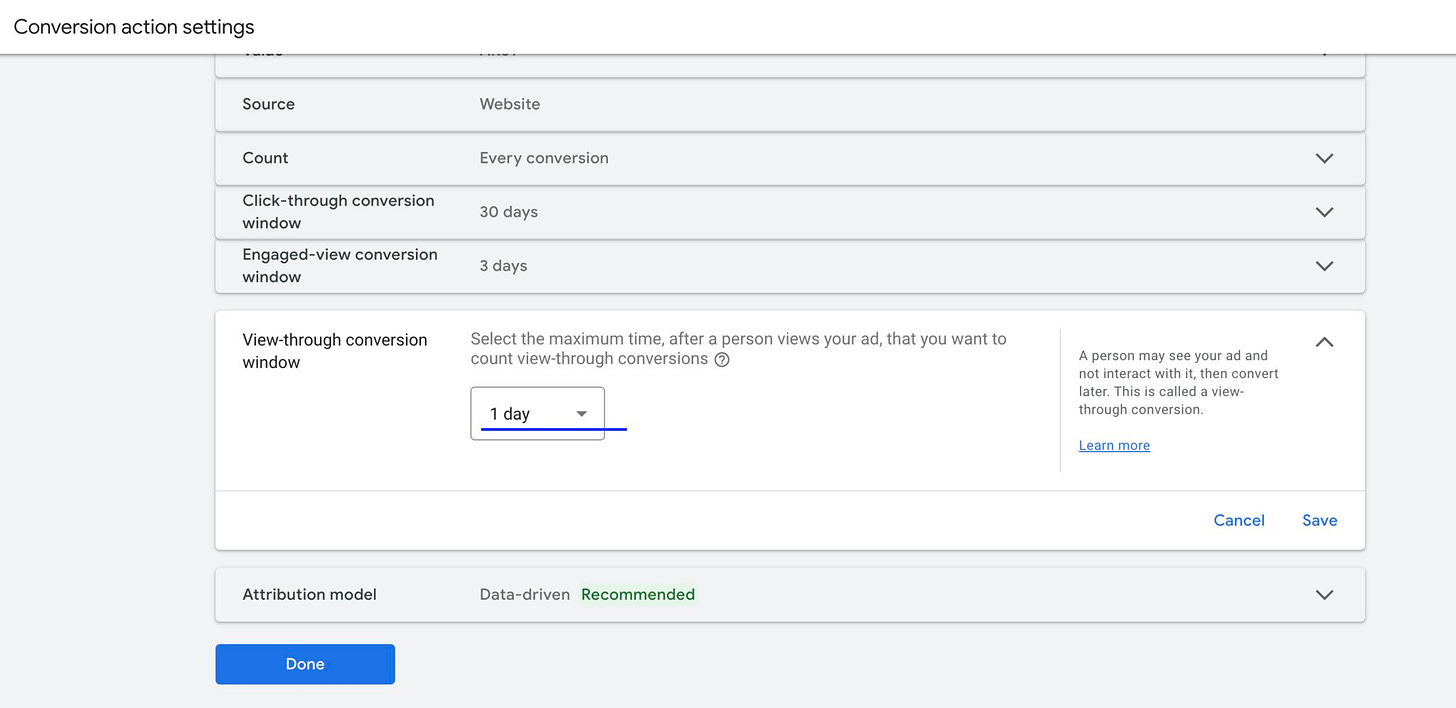Optimizing Conversions: The Unseen Power of View-Through Conversions in Google Ads
The overlooked metric in Google Ads that unlock the hidden potential of your display and video campaigns.
We’ve discussed extensively how to optimize conversions across various industries, campaigns, and strategies. However, one crucial aspect that often goes unnoticed is the relevance of View-Through Conversions in Google Ads. This metric, as some may know, measures conversions that occur without direct interactions within a specified period. It is particularly pertinent to display and video campaigns.
Understanding View-Through Conversions
View-Through Conversions (VTCs) are a type of conversion tracking in Google Ads that records when users see your ad but do not click on it, and later complete a conversion action on your site within a specific timeframe. This metric is critical for understanding the indirect impact of your display and video campaigns.
Why View-Through Conversions Matter
Holistic Campaign Performance: While click-through conversions provide direct insights, they often don’t capture the full picture. VTCs help you understand the broader influence of your ads, especially those designed for brand awareness at the top of the funnel (TOFU).
Enhanced Attribution: By analyzing VTCs, you can get a clearer view of your customer’s journey. This helps in attributing the right value to your display and video ads, ensuring that you recognize their contribution to your overall marketing efforts.
Better Budget Allocation: Understanding VTCs can inform more strategic budget allocations. If your display or video ads drive significant VTCs, you might consider investing more in these campaigns to maximize their indirect impact.
Analyzing View-Through Conversions
There may be multiple conversion actions you'll want to track because they reflect valuable activity for your business. You can select a different counting method for each conversion action.
To figure out which conversion counting option is best for each conversion action you track, let's take a closer look at the 2 counting settings:
Every conversion: With this setting, Google Ads counts every conversion (per tracked conversion action) that happens after an ad interaction. This is a good choice if you'd like to track and improve your sales, because every sale likely adds value for your business.
Example
You own a travel booking site used to reserve both hotel rooms and rental cars. You'd like to see how your ads drive each type of booking, so you choose to count every conversion. When someone traveling to Chicago, Denver, and New York books one hotel reservation in each city (3 hotel reservations) and rental cars only in Chicago and Denver (2 car reservations), this conversion setting will count 5 conversions.
One conversion: With this setting, Google Ads counts only one conversion per ad click. This is a good choice if you're not interested in the number of sales, but instead whether or not a certain kind of lead was generated. This is because usually only one, unique lead per ad click likely adds value for your business.
Example
You run an insurance company that offers home, auto, and life insurance, and measure conversions for each type of policy as a different conversion action. You'd like to see how well your ads drive people to fill out a form on your site requesting information about one or more insurance products.
You notice people sometimes fill out multiple forms with different values for the same products. If the same person fills out 3 auto-insurance forms and 2 home-insurance forms, using one conversion will show you 2 conversions: one for each conversion action.
No matter which counting method you decide on, I suggest you to add helpful reporting columns to discover how your ads lead to valuable customer actions.
Your “View-through conversions” column tells you when customers see, but don’t interact with your ad, and then later complete a conversion on your site. This is different from the data in your other conversion columns, which record when customers interact with an ad and then complete a conversion on your site.
View-through conversions are a helpful way to track the value of your display or video ad campaigns. For display campaigns, for example, they measure the conversions where a customer saw—but didn't click—an ad before completing a conversion. View-through conversions take into account the settings of your conversion actions, such as the way conversions are counted.
View-through conversions automatically exclude conversions from people who have also interacted with any of your other ads. View-through conversions are not included in the “Conversions” column, only in the “View-through conversions” and "All conversions" columns.
View-through conversions from browsers that don’t allow cross-site cookies cannot be reported.
View-through conversions for video ads
For video campaigns, view-through conversions tell you when an impression of your video ad leads to a conversion on your site. The last impression of a video ad will get credit for the view-through conversion.
Keep in mind: An impression is different than a “view” of a video ad. A “view” is counted when someone watches 30 seconds (or the whole ad if it’s shorter than 30 seconds) or clicks on a part of the ad. A “view” that leads to a conversion is counted in the “Conversions” column.
Leveraging VTC Data for Better Performance
Adjust Your Bidding Strategy: While I don’t recommend changing your conversion bid solely based on VTCs, consider how these conversions fit into your overall strategy. For instance, if VTCs show strong performance, you might explore bidding strategies that emphasize viewable impressions.
Optimize Your Conversion Window: Analyze how long it typically takes for a user to convert after viewing your ad. Depending on this data, you might adjust your conversion window to capture more accurate VTC data.
Integrate with Other Metrics: Combine VTC data with other key performance indicators like assisted conversions and time lag to gain a comprehensive view of your campaign’s impact. This integration helps in making more informed decisions about your marketing strategy.
Case Study: Maximizing Impact with VTCs
Consider a brand running a large-scale video campaign aimed at increasing brand awareness. Initially, the focus was solely on click-through conversions, which showed moderate success. However, by integrating VTC tracking, the brand discovered that many users were viewing the ads and later converting via direct traffic or organic search. This insight led to a reevaluation of the campaign’s effectiveness, resulting in increased investment in video ads and a notable rise in overall conversions.
Conclusion
View-Through Conversions are an essential yet often overlooked metric in Google Ads that can significantly enhance your understanding of campaign performance. By incorporating VTC analysis into your strategy, you can achieve a more holistic view of how your ads influence user behavior, leading to more informed decisions and optimized marketing efforts. Dive into your VTC data today and unlock the hidden potential of your display and video campaigns.







